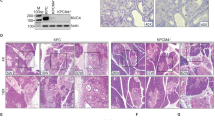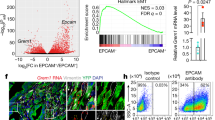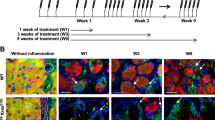Abstract
The mechanisms controlling expression of the putative oncogene Anterior gradient 2 (AGR2) in pancreatic ductal adenocarcinoma (PDAC) are not well understood. We now show that AGR2 is a transforming growth factor-β (TGF-β)-responsive gene in human pancreatic cancer cells, whose downregulation is SMAD4 dependent. We also provide evidence supporting a role for AGR2 as an ER-chaperone for the cancer-associated mucin, MUC1. AGR2 is both sufficient and required for MUC1 expression in pancreatic cancer cells. Furthermore, AGR2 is coexpressed with MUC1 in mouse pancreatic intraepithelial neoplasia (mPanIN)-like lesions and in the cancer cells of four distinct genetically engineered mouse models of PDAC. We also show that Pdx1-Cre/LSL-KrasG12D/Smad4lox/lox mice heterozygous for Agr2 exhibit a delay in mPanIN initiation and progression to PDAC. It is proposed that loss of Smad4 may convert TGF-β from a tumor suppressor to a tumor promoter by causing the upregulation of AGR2, which then leads to increased MUC1 expression, at which point both AGR2 and MUC1 facilitate mPanIN initiation and progression to PDAC.
This is a preview of subscription content, access via your institution
Access options
Subscribe to this journal
Receive 50 print issues and online access
$259.00 per year
only $5.18 per issue
Buy this article
- Purchase on Springer Link
- Instant access to full article PDF
Prices may be subject to local taxes which are calculated during checkout







Similar content being viewed by others
References
American Cancer Society. Cancer Facts & Figures. American Cancer Society, Atlanta, 2007.
Norris AM, Korc M . Smad4/TGF-b pathway: signaling pathways in pancreatic pathogenesis. In: Neoptolemos JP, Buchler M, Errutia R, (eds) Pancreatic Cancer. Springer, New York, 2009.
Hruban RH, Wilentz RE, Kern SE . Genetic progression in the pancreatic ducts. Am J Pathol 2000; 156: 1821–1825.
van Heek T, Rader AE, Offerhaus GJ, McCarthy DM, Goggins M, Hruban RH et al. K-ras, p53, and DPC4 (MAD4) alterations in fine-needle aspirates of the pancreas: a molecular panel correlates with and supplements cytologic diagnosis. Am J Clin Pathol 2002; 117: 755–765.
Hansel DE, Kern SE, Hruban RH . Molecular pathogenesis of pancreatic cancer. Annu Rev Genomics Hum Genet 2003; 4: 237–256.
Hahn SA, Schutte M, Hoque AT, Moskaluk CA, da Costa LT, Rozenblum E et al. DPC4, a candidate tumor suppressor gene at human chromosome 18q21.1. Science 1996; 271: 350–353.
Wagner M, Kleeff J, Lopez ME, Bockman I, Massaque J, Korc M . Transfection of the type I TGF-beta receptor restores TGF-beta responsiveness in pancreatic cancer. Int J Cancer 1998; 78: 255–260.
Baldwin RL, Friess H, Yokoyama M, Lopez ME, Kobrin MS, Buchler MW et al. Attenuated ALK5 receptor expression in human pancreatic cancer: correlation with resistance to growth inhibition. Int J Cancer 1996; 67: 283–288.
Kleeff J, Maruyama H, Friess H, Buchler MW, Falb D, Korc M . Smad6 suppresses TGF-beta-induced growth inhibition in COLO-357 pancreatic cancer cells and is overexpressed in pancreatic cancer. Biochem Biophys Res Commun 1999; 255: 268–273.
Arnold NB, Ketterer K, Kleeff J, Friess H, Buchler MW, Korc M . Thioredoxin is downstream of Smad7 in a pathway that promotes growth and suppresses cisplatin-induced apoptosis in pancreatic cancer. Cancer Res 2004; 64: 3599–3606.
Friess H, Yamanaka Y, Buchler M, Ebert M, Beger HG, Gold LI et al. Enhanced expression of transforming growth factor beta isoforms in pancreatic cancer correlates with decreased survival. Gastroenterology 1993; 105: 1846–1856.
Sempere LF, Gunn JR, Korc M . A novel 3-dimensional culture system uncovers growth stimulatory actions by TGFbeta in pancreatic cancer cells. Cancer Biol Ther 2011; 12: 198–207.
Kufe DW . Mucins in cancer: function, prognosis and therapy. Nat Rev Cancer 2009; 9: 874–885.
Moniaux N, Andrianifahanana M, Brand RE, Batra SK . Multiple roles of mucins in pancreatic cancer, a lethal and challenging malignancy. Br J Cancer 2004; 91: 1633–1638.
Levi E, Klimstra DS, Andea A, Basturk O, Adsay NV . MUC1 and MUC2 in pancreatic neoplasia. J Clin Pathol 2004; 57: 456–462.
Balague C, Gambus G, Carrato C, Porchet N, Aubert JP, Kim YS et al. Altered expression of MUC2, MUC4, and MUC5 mucin genes in pancreas tissues and cancer cell lines. Gastroenterology 1994; 106: 1054–1061.
Choudhury A, Moniaux N, Winpenny JP, Hollingsworth MA, Aubert JP, Batra SK . Human MUC4 mucin cDNA and its variants in pancreatic carcinoma. J Biochem 2000; 128: 233–243.
Andrianifahanana M, Moniaux N, Schmied BM, Ringel J, Friess H, Hollingsworth MA et al. Mucin (MUC) gene expression in human pancreatic adenocarcinoma and chronic pancreatitis: a potential role of MUC4 as a tumor marker of diagnostic significance. Clin Cancer Res 2001; 7: 4033–4040.
Yamamoto M, Bharti A, Li Y, Kufe D . Interaction of the DF3/MUC1 breast carcinoma-associated antigen and beta-catenin in cell adhesion. J Biol Chem 1997; 272: 12492–12494.
Li Y, Ren J, Yu W, Li Q, Kuwahara H, Yin L et al. The epidermal growth factor receptor regulates interaction of the human DF3/MUC1 carcinoma antigen with c-Src and beta-catenin. J Biol Chem 2001; 276: 35239–35242.
Schroeder JA, Thompson MC, Gardner MM, Gendler SJ . Transgenic MUC1 interacts with epidermal growth factor receptor and correlates with mitogen-activated protein kinase activation in the mouse mammary gland. J Biol Chem 2001; 276: 13057–13064.
Carraway KL, Perez A, Idris N, Jepson S, Arango M, Komatsu M et al. Muc4/sialomucin complex, the intramembrane ErbB2 ligand, in cancer and epithelia: to protect and to survive. Prog Nucleic Acid Res Mol Biol 2002; 71: 149–185.
Pohler E, Craig AL, Cotton J, Lawrie L, Dillon JF, Ross P et al. The Barrett’s antigen anterior gradient-2 silences the p53 transcriptional response to DNA damage. Mol Cell Proteomics 2004; 3: 534–547.
Persson S, Rosenquist M, Knoblach B, Khosravi-Far R, Sommarin M, Michalak M . Diversity of the protein disulfide isomerase family: identification of breast tumor induced Hag2 and Hag3 as novel members of the protein family. Mol Phylogenet Evol 2005; 36: 734–740.
Park SW, Zhen G, Verhaeghe C, Nakagami Y, Nguyenvu LT, Barczak AJ et al. The protein disulfide isomerase AGR2 is essential for production of intestinal mucus. Proc Natl Acad Sci USA 2009; 106: 6950–6955.
Higa A, Mulot A, Delom F, Bouchecareilh M, Nguyen DT, Boismenu D et al. Role of pro-oncogenic protein disulfide isomerase (PDI) family member anterior gradient 2 (AGR2) in the control of endoplasmic reticulum homeostasis. J Biol Chem 2011; 286: 44855–44868.
Liu D, Rudland PS, Sibson DR, Platt-Higgins A, Barraclough R . Human homologue of cement gland protein, a novel metastasis inducer associated with breast carcinomas. Cancer Res 2005; 65: 3796–3805.
Fritzsche FR, Dahl E, Pahl S, Burkhardt M, Luo J, Mayordomo E et al. Prognostic relevance of AGR2 expression in breast cancer. Clin Cancer Res 2006; 12: 1728–1734.
Kristiansen G, Pilarsky C, Wissmann C, Kaiser S, Bruemmendorf T, Roepcke S et al. Expression profiling of microdissected matched prostate cancer samples reveals CD166/MEMD and CD24 as new prognostic markers for patient survival. J Pathol 2005; 205: 359–376.
Hrstka R, Nenutil R, Fourtouna A, Maslon MM, Naughton C, Langdon S et al. The pro-metastatic protein anterior gradient-2 predicts poor prognosis in tamoxifen-treated breast cancers. Oncogene 2010; 29: 4838–4847.
Innes HE, Liu D, Barraclough R, Davies MP, O’Neill PA, Platt-Higgins A et al. Significance of the metastasis-inducing protein AGR2 for outcome in hormonally treated breast cancer patients. Br J Cancer 2006; 94: 1057–1065.
Riener MO, Pilarsky C, Gerhardt J, Grutzmann R, Fritzsche FR, Bahra M et al. Prognostic significance of AGR2 in pancreatic ductal adenocarcinoma. Histol Histopathol 2009; 24: 1121–1128.
Chen R, Pan S, Duan X, Nelson BH, Sahota RA, de Rham S et al. Elevated level of anterior gradient-2 in pancreatic juice from patients with pre-malignant pancreatic neoplasia. Mol Cancer 2010; 9: 149.
Brychtova V, Vojtesek B, Hrstka R . Anterior gradient 2: a novel player in tumor cell biology. Cancer Lett 2011; 304: 1–7.
Thompson DA, Weigel RJ . hAG-2, the human homologue of the Xenopus laevis cement gland gene XAG-2, is coexpressed with estrogen receptor in breast cancer cell lines. Biochem Biophys Res Commun 1998; 251: 111–116.
Lowe AW, Olsen M, Hao Y, Lee SP, Taek Lee K, Chen X et al. Gene expression patterns in pancreatic tumors, cells and tissues. PLoS ONE 2007; 2: e323.
Iacobuzio-Donahue CA, Maitra A, Olsen M, Lowe AW, van Heek NT, Rosty C et al. Exploration of global gene expression patterns in pancreatic adenocarcinoma using cDNA microarrays. Am J Pathol 2003; 162: 1151–1162.
Dumartin L, Whiteman HJ, Weeks ME, Hariharan D, Dmitrovic B, Iacobuzio-Donahue CA et al. AGR2 is a novel surface antigen that promotes the dissemination of pancreatic cancer cells through regulation of cathepsins B and D. Cancer Res 2011; 71: 7091–7102.
Wang Z, Hao Y, Lowe AW . The adenocarcinoma-associated antigen, AGR2, promotes tumor growth, cell migration, and cellular transformation. Cancer Res 2008; 68: 492–497.
Ramachandran V, Arumugam T, Wang H, Logsdon CD . Anterior gradient 2 is expressed and secreted during the development of pancreatic cancer and promotes cancer cell survival. Cancer Res 2008; 68: 7811–7818.
Chang KC, Komm B, Arnold NB, Korc M . The application of differential display as a gene profiling tool. Methods Mol Biol 2007; 383: 31–40.
Hahn SA, Hoque AT, Moskaluk CA, da Costa LT, Schutte M, Rozenblum E et al. Homozygous deletion map at 18q21.1 in pancreatic cancer. Cancer Res 1996; 56: 490–494.
Sipos B, Moser S, Kalthoff H, Torok V, Lohr M, Kloppel G . A comprehensive characterization of pancreatic ductal carcinoma cell lines: towards the establishment of an in vitro research platform. Virchows Arch 2003; 442: 444–452.
Heldin CH, Miyazono K, ten Dijke P . TGF-beta signalling from cell membrane to nucleus through SMAD proteins. Nature 1997; 390: 465–471.
Dennler S, Itoh S, Vivien D, ten Dijke P, Huet S, Gauthier J-M . Direct binding of Smad3 and Smad4 to critical TGF[beta]-inducible elements in the promoter of human plasminogen activator inhibitor-type 1 gene. EMBO J 1998; 17: 3091–3100.
Massague J, Seoane J, Wotton D . Smad transcription factors. Genes Dev 2005; 19: 2783–2810.
Jonk LJC, Itoh S, Heldin C-H, ten Dijke P, Kruijer W . Identification and functional characterization of a smad binding element (SBE) in the JunB promoter that acts as a transforming growth factor-Œ≤, activin, and bone morphogenetic protein-inducible enhancer. J Biol Chem 1998; 273: 21145–21152.
Zheng W, Rosenstiel P, Huse K, Sina C, Valentonyte R, Mah N et al. Evaluation of AGR2 and AGR3 as candidate genes for inflammatory bowel disease. Genes Immun 2006; 7: 11–18.
Lagna G, Hata A, Hemmati-Brivanlou A, Massague J . Partnership between DPC4 and SMAD proteins in TGF-beta signalling pathways. Nature 1996; 383: 832–836.
Zawel L, Dai JL, Buckhaults P, Zhou S, Kinzler KW, Vogelstein B et al. Human Smad3 and Smad4 are sequence-specific transcription activators. Mol Cell 1998; 1: 611–617.
Forstner G . Signal transduction, packaging and secretion of mucins. Annu Rev Physiol 1995; 57: 585–605.
Hingorani SR, Petricoin EF, Maitra A, Rajapakse V, King C, Jacobetz MA et al. Preinvasive and invasive ductal pancreatic cancer and its early detection in the mouse. Cancer Cell 2003; 4: 437–450.
Bardeesy N, Aguirre AJ, Chu GC, Cheng KH, Lopez LV, Hezel AF et al. Both p16(Ink4a) and the p19(Arf)-p53 pathway constrain progression of pancreatic adenocarcinoma in the mouse. Proc Natl Acad Sci USA 2006; 103: 5947–5952.
Bardeesy N, Cheng KH, Berger JH, Chu GC, Pahler J, Olson P et al. Smad4 is dispensable for normal pancreas development yet critical in progression and tumor biology of pancreas cancer. Genes Dev 2006; 20: 3130–3146.
Carriere C, Gore AJ, Norris AM, Gunn JR, Young AL, Longnecker DS et al. Deletion of rb accelerates pancreatic carcinogenesis by oncogenic kras and impairs senescence in premalignant lesions. Gastroenterology 2011; 141: 1091–1101.
Nagata K, Horinouchi M, Saitou M, Higashi M, Nomoto M, Goto M et al. Mucin expression profile in pancreatic cancer and the precursor lesions. J Hepatobiliary Pancreat Surg 2007; 14: 243–254.
Riggins GJ, Thiagalingam S, Rozenblum E, Weinstein CL, Kern SE, Hamilton SR et al. Mad-related genes in the human. Nat Genet 1996; 13: 347–349.
Jaffee EM, Hruban RH, Canto M, Kern SE . Focus on pancreas cancer. Cancer Cell 2002; 2: 25–28.
Wilentz RE, Iacobuzio-Donahue CA, Argani P, McCarthy DM, Parsons JL, Yeo CJ et al. Loss of expression of Dpc4 in pancreatic intraepithelial neoplasia: evidence that DPC4 inactivation occurs late in neoplastic progression. Cancer Res 2000; 60: 2002–2006.
Wilentz RE, Hruban RH . Pathology of cancer of the pancreas. Surg Oncol Clin N Am 1998; 7: 43–65.
Zhang X, Ali TZ, Hua Z . ErbB3 binding protein 1 represses metastasis-promoting gene anterior gradient protein 2 in prostate cancer. Cancer Res 2010; 70: 240–248.
Ambolet-Camoit A, Bui LC, Pierre S, Chevallier A, Marchand A, Coumoul X et al. 2,3,7,8-Tetrachlorodibenzo-p-dioxin counteracts the p53 response to a genotoxicant by upregulating expression of the metastasis marker AGR2 in the hepatocarcinoma cell line HepG2. Toxicol Sci 2010; 115: 501–512.
Wilson CL, Sims AH, Howell A, Miller CJ, Clarke RB . Effects of oestrogen on gene expression in epithelium and stroma of normal human breast tissue. Endocr Relat Cancer 2006; 13: 617–628.
Zhang JS, Gong A, Cheville JC, Smith DI, Young CY . AGR2, an androgen-inducible secretory protein overexpressed in prostate cancer. Genes Chromosomes Cancer 2005; 43: 249–259.
Roy LD, Sahraei M, Subramani DB, Besmer D, Nath S, Tinder TL et al. MUC1 enhances invasiveness of pancreatic cancer cells by inducing epithelial to mesenchymal transition. Oncogene 2011; 30: 1449–1459.
Besmer DM, Curry JM, Roy LD, Tinder TL, Sahraei M, Schettini J et al. Pancreatic ductal adenocarcinoma mice lacking mucin 1 have a profound defect in tumor growth and metastasis. Cancer Res 2011; 71: 4432–4442.
Boyer Arnold N, Korc M . Smad7 abrogates transforming growth factor-beta1-mediated growth inhibition in COLO-357 cells through functional inactivation of the retinoblastoma protein. J Biol Chem 2005; 280: 21858–21866.
Carriere C, Seeley ES, Goetze T, Longnecker DS, Korc M . The Nestin progenitor lineage is the compartment of origin for pancreatic intraepithelial neoplasia. Proc Natl Acad Sci USA 2007; 104: 4437–4442.
Gu G, Dubauskaite J, Melton DA . Direct evidence for the pancreatic lineage: NGN3+ cells are islet progenitors and are distinct from duct progenitors. Development 2002; 129: 2447–2457.
Acknowledgements
We thank Dr Ted R Hupp (U of Edinburgh) for the AGR2-RFP and pcDNA-AGR2 plasmids; Dr Park (UCSF) for providing the Agr2−/− mice; Dr J Gore for helpful discussions; and Ms Catherine Chen for excellent laboratory work. This research was supported by the US Public Health Service Grant CA-R37-075059, awarded by the National Cancer Institute to MK. AMN was supported by the NRSA Molecular and Toxicology Program fellowship 5T32CA009658-18. AB was supported by the Program in Experimental and Molecular Medicine.
Author information
Authors and Affiliations
Corresponding author
Ethics declarations
Competing interests
The authors declare no conflict of interest.
Additional information
Supplementary Information accompanies the paper on the Oncogene website
Supplementary information
Rights and permissions
About this article
Cite this article
Norris, A., Gore, A., Balboni, A. et al. AGR2 is a SMAD4-suppressible gene that modulates MUC1 levels and promotes the initiation and progression of pancreatic intraepithelial neoplasia. Oncogene 32, 3867–3876 (2013). https://doi.org/10.1038/onc.2012.394
Received:
Revised:
Accepted:
Published:
Issue Date:
DOI: https://doi.org/10.1038/onc.2012.394
Keywords
This article is cited by
-
Anterior gradient proteins in gastrointestinal cancers: from cell biology to pathophysiology
Oncogene (2022)
-
Effects of ER-resident and secreted AGR2 on cell proliferation, migration, invasion, and survival in PANC-1 pancreatic cancer cells
BMC Cancer (2021)
-
MUC1 oncoprotein mitigates ER stress via CDA-mediated reprogramming of pyrimidine metabolism
Oncogene (2020)
-
AGR2-induced glucose metabolism facilitated the progression of endometrial carcinoma via enhancing the MUC1/HIF-1α pathway
Human Cell (2020)
-
Suppression of AGR2 in a TGF-β-induced Smad regulatory pathway mediates epithelial-mesenchymal transition
BMC Cancer (2017)



